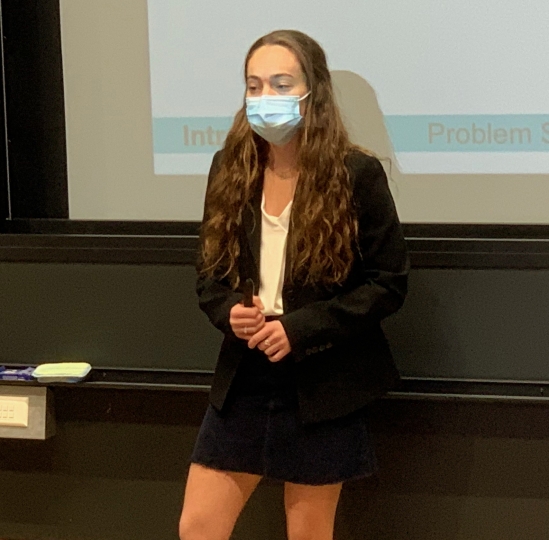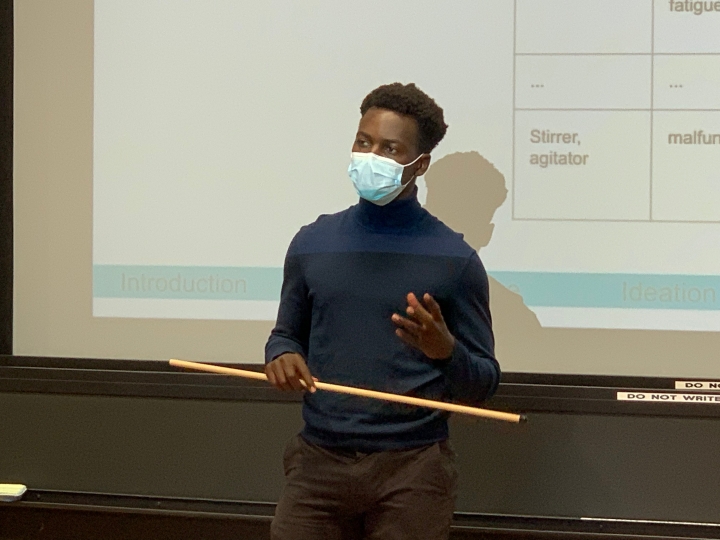News
Plastics have provided a plethora of benefits to human society since their creation. But understanding the impacts of plastic pollution, and the generation and impacts of micro- and nanoplastics, is of increasing importance. The science of micro- and nanoplastics is still in its infancy. Micro- and nanoplastic particles litter our oceans and freshwater reserves with many unknown impacts.
Select studies indicate microplastics can negatively impact certain marine and freshwater species at high concentrations. Scientists are investigating the potential effects of microplastics on human health through inhalation and ingestion.
A team of third-year students at the Harvard John A. Paulson School of Engineering and Applied Sciences (SEAS) spent last semester designing a method to monitor and capture micro- and nanoplastics in wastewater.
The challenge was set by BASF, one of the world’s leading chemical producers, which was the “client” in the SEAS course, ES96: Engineering Problem Solving and Design Project.
The students’ solution: use microbubbles to stir up the particles in a reactor, then add a compound to force the particles to the surface, where they can then be easily skimmed into a collector basin.
The students -- Maggie Schultz, Abigail Huebner, Sydney Kepler, Jules Muhizi, Tony Paganis, Alessio Pignatelli, Estel Valeanu and Ursula Volz -- presented their design in the final week of the Fall 2021 semester.
Group leader Maggie Schultz presents her team's strategy to monitor and remove micro- and nanoplastic particles from water supplies to BASF on December 13 at the Science and Engineering Complex in Allston. Schultz led a group of eight SEAS juniors in the semester-long project for ES96: Engineering Problem Solving and Design Project. (Credit: Matt Goisman/SEAS)
“I was expecting to really get a sense of working with a team,” said Schultz, the project’s manager. ”We’re all engineers, but since we came from different specific types of engineering, it was really interesting to work within a team that diverse. I definitely think that was a big learning outcome for me.”
Although a universal definition is lacking, microplastics are typically defined as solid synthetic polymer particles ranging from 100 nanometers to 5 millimeters in length. Nanoplastics, even less understood than microplastics, are commonly considered to be 1 to 100 nanometers in length. At these sizes, nanoplastics have different physical properties and behaviors than their larger counterparts.
BASF is working to advance micro- and nanoplastics science by developing techniques that allow scientists to better characterize and understand these materials. This includes investigating future methodologies to capture microplastics.
BASF colleagues wanted ES96 to focus on nylon and polyurethane micro- and nanoplastic particles, two polymers that have vastly different physical properties. Nylon is most often used in clothing and other textiles but is also used in injection molding applications and food packaging. Polyurethane, especially polyurethane foam, is used in numerous commercial products, including sponges, footwear, and automotive seating.
“It’s a very challenging problem,” said Samir Mitragotri, Hiller Professor of Bioengineering and Hansjorg Wyss Professor of Biologically Inspired Engineering and course instructor for ES96. “Certainly a problem that is in urgent need of a solution.”
Selecting a final strategy proved to be one of the biggest challenges for the group. ES96 design groups tend to be larger than anything SEAS students experience in their first two years, and with eight members came eight (or more) potential strategies.
“Everybody has a different perspective, different experience,” Mitragotri said. “Because of that, the proposed solutions were so different, and the synthesis of all those ideas to collectively come towards one idea was a very interesting journey. That’s one skill that they’ll carry on to their professional lives.”
Ideas included using magnetic extraction and cellulose filters to remove nanoplastics, monitoring nanoplastic concentrations with artificial intelligence and computer vision, and creating a ceramic filtration system with automated nanoparticle tracking. The group then weighed each potential solution against a series of criteria, such as environmental friendliness, innovation, flexibility, scalability and accuracy.
Jules Muhizi presents his group's strategy to monitor and remove micro- and nanoplastic particles from water supplies to BASF on December 13 at the Science and Engineering Complex in Allston. (Credit: Matt Goisman/SEAS)
“We went from 10 ideas to two ideas to one main idea,” Muhizi said. “To go from 10 ideas that are very different to two ideas that are very similar takes a lot of analysis of what the criteria are that are most important to us.”
“This course really emphasizes the ideation process,” Kepler said.
The microbubble strategy, first suggested by Kepler, ended up as the most feasible. Her idea came from a student internship in which she learned how microbubbles could be used in drug delivery.
Once the group decided on an approach, experimentation followed in the Active Learning Labs.
SEAS and BASF have had a longstanding, productive collaboration for the last 15 years. The two organizations launched the BASF Advanced Research Initiative at SEAS in October 2007. That partnership evolved into the Northeast Research Alliance, a collaboration between Harvard, BASF, the Massachusetts Institute of Technology and the University of Massachusetts Amherst, formed in 2012 and currently headed by Rupert Konradi.
“We were wowed by the final presentation from the student team,” said Jeanne Hankett, BASF senior scientist and manager for its North American Microplastic Research Network. “They conducted detailed, well thought-out investigations, and proposed a novel and exciting solution for microplastics capture and abatement harnessing microbubbles. It was clear that the Harvard Engineering students learned a great deal about the challenges with capture and analysis of micro- and nanoparticles, and that they understood universal needs for developing robust monitoring and capture systems to support exposure research and abatement.”
Topics: Environment
Cutting-edge science delivered direct to your inbox.
Join the Harvard SEAS mailing list.
Press Contact
Matt Goisman | mgoisman@g.harvard.edu




